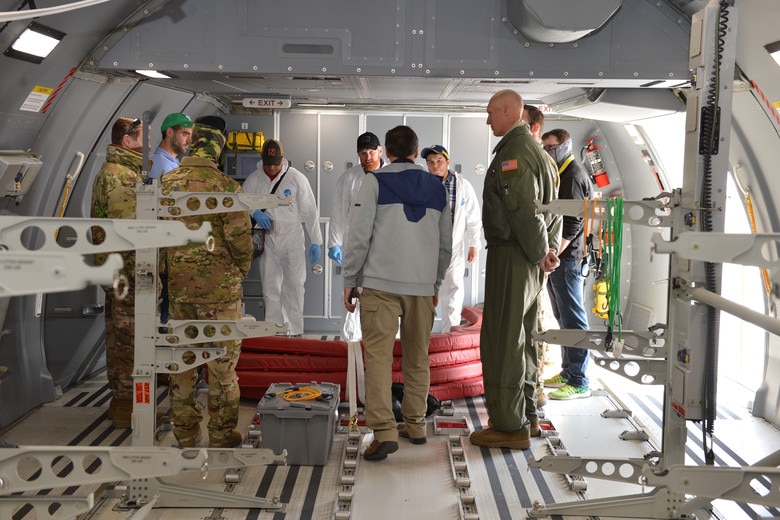The U.S. Air Force's Air Mobility Command sent multiple airframes to the Nebraska Air National Guard base to test airflow and reduce the risk to aircrews transporting COVID-19 patients.
"United States Transportation Command expressed a joint, urgent, operational-need request for high-capacity airlift of COVID-19 passengers," said Maj. Dave Sustello, AMC Test and Evaluation Squadron operations officer.
Active duty, Reserve and Air National Guard components from AMC, in coordination with the University of Nebraska Medical Center and Defense Advanced Research Projects Agency, worked April 4-11 at the 155th Air Refueling Wing examining airflow and particles to assess ways to prevent the spread of the coronavirus to aircrew.
The first airflow tests were conducted on the KC-135 Stratotanker, C-17 Globemaster III and C-130J Hercules aircraft, followed by the KC-46 Pegasus, KC-10 Extender and C-5M Super Galaxy.
"(We're) evaluating different airframes for the ability to transport potentially symptomatic patients safely while protecting aircrew and medical personnel," said Dr. Joshua Santarpia, UNMC Microbiology and Pathology associate professor. "(To do this, we're) looking at what happens to particles produced by people and how they might move around the airframe."
Experts from multiple scientific fields used a method of dispersing aerosol DNA tag beads during the process, a concept Santarpia invented two years ago.
After the beads were released, multiple tests were performed in the air and on the ground. These included taping off and numbering small areas of the aircraft's floor to capture surface samples.
"Basically, we run multiple tasks on an airframe to understand if bead one, released at the rear of the aircraft, made it up to the front; or if bead two, released in the middle of the plane, (made) it up to the front of the aircraft," said Dillan Cunningham, with the National Strategic Research Institute at the university.
Cunningham said understanding the airframe's aerodynamics - the airflow - is vital to minimizing the spread of infectious molecules in the aircraft.
"The best potential way to achieve success of this mission is understanding the best configuration to transport personnel, servicemen and women, and everyone else back home for treatment without potentially infecting everyone, endangering other people and putting undue risk and burden on the crew," Cunningham said.
Sustello credited UNMC and all the entities that took part in this mission to preserve and protect the health of the mobility force.
"This was world-class support," Sustello said. "Anything and everything that we've asked for they've been able to provide, and I'm seeing that Nebraska work ethic shine through."
The 155th Air Refueling Wing was selected for the high-priority mission because of the proximity of the air base, allowing multiple aircraft to fly in and remain on the ramp-space provided.
"The testing that took place this week is all about mitigating the risk to our Airmen while providing combatant commanders around the world with the capability to rapidly repatriate personnel who are either infected or exposed to COVID-19," said Col. John Williams, 155th Air Refueling Wing, Operations Group commander. "The research is not just applicable to the current outbreak. The lessons learned here in Nebraska will be valuable to future operations as well."

Members from the University of Nebraska's National Strategic Research Institute, KC-46 Pegasus crew members and 155th Air Refueling Wing Airmen discuss airflow particle test results at the 155th ARW, Nebraska National Guard Air Base, Lincoln, Neb., April 10, 2020. The Air Mobility Command, the university's medical center and the Defense Advanced Research Projects Agency examined airflow to assess ways to eliminate virus transmission to aircrew when transporting COVID-19 patients. (U.S. Air National Guard photo by Senior Master Sgt. Shannon Nielsen)






